Renowned for its beautiful architecture, scarily advanced technology, and strong tradition, Japan remains one of the most fascinating countries to culturally dissect. However, it is the nation’s eccentric game shows, colorful anime, and unusual gadgets that seem to generate considerable attention. The same fervent interest lies in Japanese food. Japan’s gastronomical delights have evolved through centuries of social, political, and economic shifts. The region’s chefs are notorious for their fusion cuisine, combing dishes from around the world with their own culinary flair. Such emphasis on innovation and originality has led to a mishmash of novel, interesting, and downright strange creations. As you will see from this list, the Japanese certainly adhere to the “try everything once” school of thought in terms of food.
#10 Fish Sperm (Shirako)
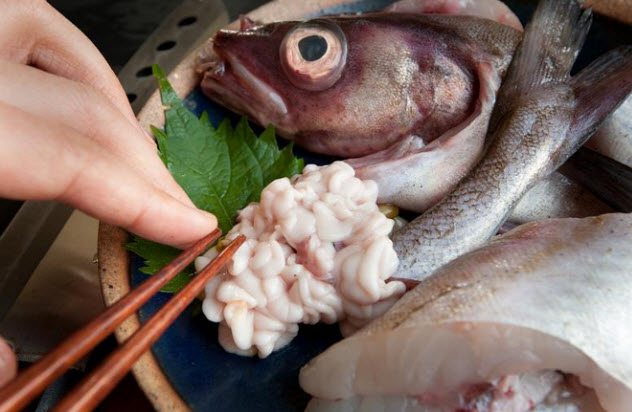
The Japanese love a bit of piscine semen. For that matter, the dish has spread throughout the civilized world. Americans call it “milt.” The Japanese call it shirako. The Russians relish a little moloka (herring milt).Reminiscent of the human brain’s slimy labyrinth of gyri and fissures, shirako is actually the fluid-filled sperm sac of a fish. Although the sac is most often extracted from cod, it is sometimes taken from salmon, puffer fish, and anglerfish.
Shirako is served in a variety of formats. Chefs have been known to deep-fry the reproductive apparatus in batter, saute it, or put it in a hot pot. For hard-core diners, shirako is frequently served raw with spring onions, leeks, and a citrus dressing. In terms of taste, the semen-packed snack is creamy, mildly sweet, and has a hint of tofu about it.[1]It may have all the aesthetic appeal of a Tim Burton film prop, but at least it offers some nutritional value. The fishy dish is packed with vitamin B, calcium, potassium, and protein.
Caviar might not seem like such an unpalatable dish after all.
#9 Kare Donatsu
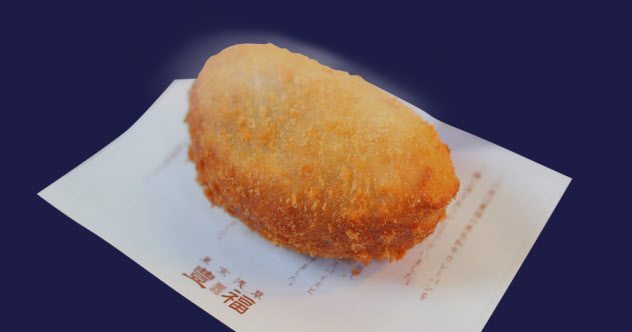
The Japanese have taken a traditional Indian dish and put a unique spin on it. Simply put, kare donatsu is a deep-fried doughnut filled with curry. The inexpensive snack, costing a mere couple of bucks, is sold at bakeries and stores across Japan. Tokyo’s Toyofuku bakery proudly claims that it has produced kare donatsu using Japanese beef for more than a century.
Inspired by the kare donatsu recipe, Japanese confectionary company Tirol decided to release another bizarre curry creation—curry chocolates. These bite-size snacks, called Kare Pan Tirol, have a chocolate, curry, and crunchy bread interior. The emergence of curry doughnuts even spawned “Kare Pan Man” (Curry Bread Man), an anime superhero made of curry bread.
Curry was first used in Japan during the mid-1800s. It is believed that English merchants of the Japanese port city Kobe first introduced the country to curry powders. Curry dishes quickly spread through cookbooks and became a staple diet of the Japanese navy.
In the 1930s, a Japanese merchant sampled curry rice aboard a steamship bound for Europe. Upon his return, he began selling an affordable version of the dish in his Osaka department store. It was an instant hit and led to curry houses appearing all over Japan.[2]
#8 Dancing Squid
The dancing squid (katsu ika odori-don) is both a Japanese delicacy and viral sensation. As the name suggests, the squid serves as an acrobatic jester to restaurant goers. Dousing the cephalopod in soy sauce leads to an electrical response in the creature’s limbs. More specifically, it is the salt in the soy sauce that causes the tentacles to thrash, making it seem as if the squid were still alive.
As the squid is freshly killed, much of the tissue is still functional. The sodium chloride within the sauce triggers action potentials in the sensory neurons of the tentacles. A series of electrical signals are then sent to the muscles, causing them to contract and relax. Since the squid’s muscle cells still possess energy reserves in the form of adenosine triphosphate (ATP), movement is still possible.
The dancing squid has courted controversy online, with some viewers complaining about animal cruelty. However, the squid’s brain is removed during cooking. As a result, the squid is dead and cannot feel pain.[3]The same phenomenon is at play when salt is sprinkled over severed frog legs. For those of a morbid disposition, it is worth mentioning that a similar experiment was performed on a dead convict during the early 1800s.The dancing squid is sold at Ikkatei Tabiji, a restaurant in Hakodate. It is typically served alongside rice, salmon roe, and shiso leaves.
#7 Shiro-uo (Ice Gobies)
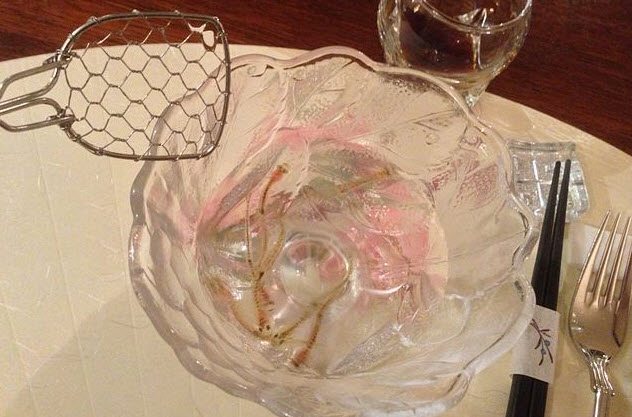
Here is another piece of “dancing” cuisine. Unlike the dancing squid, however, these sea creatures are sometimes alive when consumed. Shiro-uo are tiny, translucent fish. When placed in the mouth, they are said to do the odorigui dance.
More generally, the Japanese word odorigui refers to eating seafood that is still moving. This can occur when the creature is alive (e.g., shiro-uo) or dead (e.g., katsu ika odori-don). More commonly, though, shiro-uo are consumed when they are motionless and dead. For example, they are frequently used as a rice topping.Caught throughout the Kyushu and Honshu islands of Japan, living gobies are sold at premium prices. Different regions use different types of small fish in their dishes. Fukuoka (Kyushu) chefs use ice gobies, whereas those from Iwakuni (western Honshu) use whitebait.
Many intrepid adventurers flock to Fukuoka’s Koharu restaurant to eat shiro-uo. This temporary structure overlooks the Muromi River, where local fishermen spend their days capturing unsuspecting shiro-uo.Once inside the famed establishment, patrons mix the cold-blooded dancers with a vinegar and egg mix. With chopsticks at the ready, consumers are left to embrace the splendors of the odorigui dance. At the discretion of the customer, the fish are then either chewed or swallowed whole.[4]
#6 Wasps, Hornets, Bees, And Their Larvae
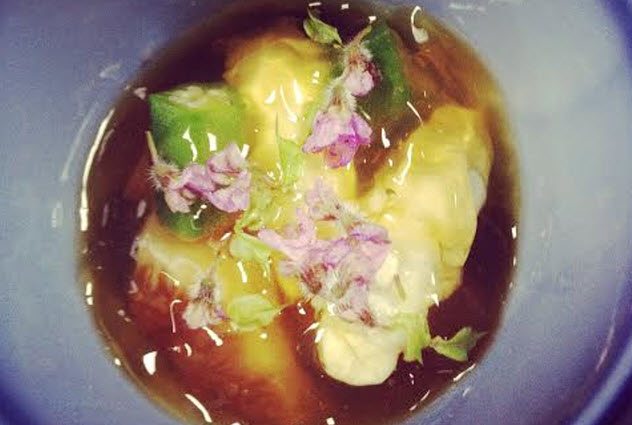
To most, these insects are picnic-plundering pests. To the Japanese, they represent a delicious snack. In fact, Emperor Hirohito was known to engage in a spot of entomophagy, munching away on a diet of wasps and rice.
Somewhere in Japan is a man chasing down a flag-waving wasp. These “wasp hunters” place small lumps of meat around the forested slopes of central Japan, waiting for the carnivorous critters to take a piece back to their nest. Affixed to the meat is a little white flag that allows the hunters to trace the wasp through the air.
Once the nest is located, the group incapacitates the wasps using smoke. Parts of the larvae-rich nest are then taken away and used in Japanese cuisine. It is even possible to purchase cans of wasp larvae from stores and packets of bee larvae from vending machines.
Hunters search for nests of the Asian giant hornet (aka the yak killer) using a similar technique. The powerful adult hornets are lured into a large container of shochu alcohol and left to ferment. The end result is an intoxicating hornet juice packed with vitamin C and protein. Meanwhile, the larvae is harvested from the nest and used in a variety of dishes, including appetizers, broths, and tempura.[5]Japan’s insect-eating ways have put the country on the map. Thrill-seeking tourists travel from all over the world to try the island nation’s rice grasshoppers, silk pupae, and giant water bugs. Mouthwatering.
#5 Square Watermelons
Who knew that molding fruit into a variety of unconventional shapes could become such a prolific market? But that is the legacy of one Japanese farmer who created the square watermelon.
The square fruit was originally devised as an elegant solution to stacking and refrigeration issues. Apparently, the Japanese thought that traditional watermelons were difficult to stack and took up too much space in refrigerators.
Farmers grew the watermelons in square, glass cages, thereby molding them into a more practical shape. The dimensions of the glass containers corresponded closely to those of the refrigeration units.
Alas, square watermelons never enjoyed mass appeal. The square fruit was far more expensive than traditional watermelons and, once picked, took longer to ripen. Overall, the molding process diminished the product’s quality. As a result, square watermelons are now sold as decorative items, fetching hundreds of dollars each.
This obsession with fruit molding has spread to other countries, including Brazil, the United States, Canada, China, and Panama. Chinese company Fruit Mould is renowned for selling skull pumpkins, watermelon hearts, Buddha pears, and other so-called “fashion fruits.”
In Japan, high-end fruit is often given to loved ones during the gift-giving seasons, Chugen and Seibo. In 2016, a pair of melons went for over $27,000 at a market auction in Hokkaido. Bunches of behemoth-sized strawberries and grapes can go for hundreds of dollars. Top fruit stores sell oversized, blemish-free apples, mangoes, and pears at similarly exorbitant prices.[6]
#4 Novelty Ice Cream
Japan is famed for its novelty ice creams. Many of the unorthodox ingredients locked within these pungent scoops will make your taste buds do somersaults. From raw horse flesh to tulips, it would seem there is a flavor to suit any palate.
One of the most popular attractions in Tokyo is Namco’s Namja Town, home of the now-defunct Ice Cream City. Smaller ice cream and dessert stalls were set up following the museum’s closure. However, in its heyday, Ice Cream City was known for its squid ink, soy sauce, oyster, shark fin, beer, and whiskey-flavored ice cream offerings.
Every year, Japan celebrates “Ice Cream Day.” On May 9, in the Saitama prefecture, ice cream aficionados celebrate the day by sampling 100 different flavors. Some of the more unusual recipes have included crab, eel, and octopus.
Octopus and jellyfish ice creams are also available from the Kumamoto (Kyushu) and Yamagata (Honshu) prefectures, respectively. From the town of Bizen, it is possible to buy ice cream that has chunks of deep-fried oysters jutting from the sides.
And if you ever fancied a bit of pit viper ice cream, Japan is your ticket. The ice cream’s distinctive flavor leaves much to be desired. Some say it tastes like vomit. More charitably, others claim it has an air of garlic and almond. Many Japanese citizens believe the venomous reptile, called mamushi, has powerful aphrodisiac qualities and improves the nervous and circulatory systems.[7]
#3 Green Caviar (aka Sea Grapes)

The deceptively named “green caviar” (umi budou) is actually a type of seaweed. Grown in the shallow waters around Okinawa Island, situated in the south of Japan, the algae form bunches of green spheres. As the seaweed is transported in darkness, it temporarily loses its distinctive green coloring. The color returns when the “sea grapes” are exposed to low-intensity light.
The food is typically consumed raw in salads along with the citrus-based dipping sauce ponzu. The spheres have a slimy texture, and they burst in the mouth to release a slightly salty flavor. Japanese chefs also use the seaweed as a garnish for various types of seafood, including smoked salmon blini and tuna sashimi.[8]Sea grapes have high nutritional value, boasting carbohydrates, protein, fiber, omega-3, antioxidants, and minerals. However, some studies have suggested that the seaweed (Caulerpa lentillifera) may contain “appreciable amounts of cadmium,” leading to fears over potential toxicity.
The seaweed is popular in other Asian countries, too, regularly appearing on menus throughout the Philippines and Malaysia.
#2 Horumon
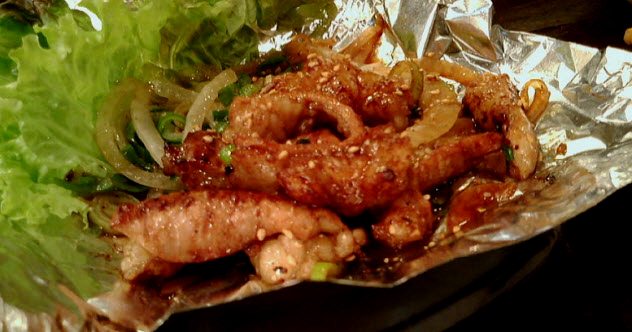
The Japanese take a “waste not, want not” approach to the island’s resources. They even have a special word, mottainai, that expresses their disdain for wasteful behavior.
The concept behind this ancient Buddhist philosophy explains why many Japanese residents save wrapping paper, reuse discarded sink water in toilets, and turn old kimonos into purses, fans, and chopstick holders.
Japanese cuisine is no different, with the dish horumon perfectly encapsulating the country’s mottainai spirit. Horumon (“things to discard”) is a post–World War II viand that involves cooking offal and tripe. It is considered an inexpensive, working-class meal and is found throughout eateries in the Kansai region of Honshu.
The dish uses beef or pork and can include the diaphragm, esophagus, intestine, kidney, liver, rectum, and stomach. While these parts are often skewered and grilled (horumonyaki), many prefer to deep-fry the meat in batter (horumon tempura), stir-fry it with noodles, or cook it in a hot pot (horumon nabe).[9]
#1 Turtle
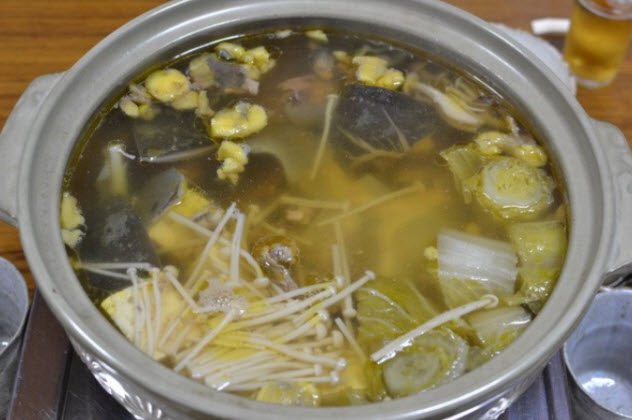
Suppon (Pelodiscus sinensis) is an expensive Asian cuisine. The dish’s popularity perhaps stems from unsubstantiated claims that the soft-shelled turtle affords increased energy, strength, and virility. Suppon oil extract is even sold as an unproven treatment for erectile dysfunction.
The creature inhabits the lakes, rivers, canals, ponds, and rice fields of Honshu and Kyushu, feasting on a diet of fish, mollusks, insects, and local flora. It is also specially bred on turtle farms for human consumption.
While suppon is seen as an alluring treat in urban hubs like Kyoto and Tokyo, it is also sold in rural restaurants at a fraction of the price. Suppon meals typically go for a minimum of 10,000 yen (over $88) in many city restaurants.
During preparation, the turtle’s neck is cut while the animal is still alive. This allows the chef to collect the blood. The blood is then consumed with or without sake according to the patron’s preference. The body of the reptile is chopped into pieces and cooked in a nabe pot to produce a vegetable-and-suppon broth. Alternative dishes incorporate the collagen-rich meat into seafood broths, stir-fries, and ramens.[10]
